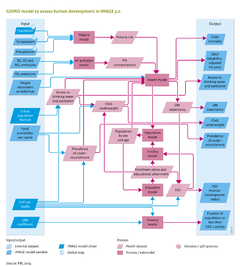Human development/Policy issues: Difference between revisions
Jump to navigation
Jump to search
No edit summary |
No edit summary |
||
| Line 2: | Line 2: | ||
|Status=On hold | |Status=On hold | ||
|Reference=PBL, 2009; PBL, 2012; Hilderink et al., 2009; | |Reference=PBL, 2009; PBL, 2012; Hilderink et al., 2009; | ||
|Description=In the past, the [[GISMO model]] has been used to evaluate several baseline scenarios, including the baseline scenario of the Rio+20 study. In this scenario (and in most others), access to food, improved drinking water, basic sanitation and modern energy sources all increase significantly up to 2050. Yet, even under large increases, a significant proportion of the population will still be without adequate services, mainly in sub-Saharan Africa and South Asia. By 2050, around 300 million people will be without adequate access to food, 250 million without sustainable access to safe drinking water, 1.4 billion without basic sanitation and 1.9 billion without access to modern energy sources for cooking and heating. Global child mortality is projected to reduce significantly, from 67 deaths per 1000 children born in 2010 to fewer than 45 by 2030 and 28 by 2050, with large improvements in all world regions (see the left part of the figure below). To comply with MDG4, child mortality, by 2015, should be reduced to around 30 deaths per 1000 children born. Without new policies, this target will not be achieved before 2030, mainly due to persistent high levels of child mortality in sub-Saharan Africa and South Asia (see also [[PBL, 2009]]). | |Description=In the past, the [[GISMO model]] has been used to evaluate several baseline scenarios, including the baseline scenario of the [[Roads from Rio+20 (2012)|Rio+20]] study. In this scenario (and in most others), access to food, improved drinking water, basic sanitation and modern energy sources all increase significantly up to 2050. Yet, even under large increases, a significant proportion of the population will still be without adequate services, mainly in sub-Saharan Africa and South Asia. By 2050, around 300 million people will be without adequate access to food, 250 million without sustainable access to safe drinking water, 1.4 billion without basic sanitation and 1.9 billion without access to modern energy sources for cooking and heating. Global child mortality is projected to reduce significantly, from 67 deaths per 1000 children born in 2010 to fewer than 45 by 2030 and 28 by 2050, with large improvements in all world regions (see the left part of the figure below). To comply with MDG4, child mortality, by 2015, should be reduced to around 30 deaths per 1000 children born. Without new policies, this target will not be achieved before 2030, mainly due to persistent high levels of child mortality in sub-Saharan Africa and South Asia (see also [[PBL, 2009]]). | ||
|Example=Policy interventions to decrease human health loss and child mortality rates can be classified as: | |Example=Policy interventions to decrease human health loss and child mortality rates can be classified as: | ||
# (primary) prevention, i.e. eliminating or reducing health risks; | # (primary) prevention, i.e. eliminating or reducing health risks; | ||
Revision as of 12:13, 17 December 2013
Parts of Human development/Policy issues
| Component is implemented in: |
|
| Related IMAGE components |
| Projects/Applications |
| Models/Databases |
| Key publications |
| References |
